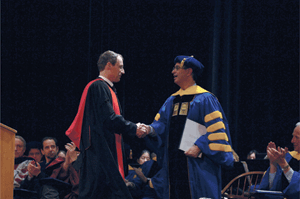

Q&A
Lennie: College Plans for Future
 INVESTITURE: President Seligman congratulates Lennie during the ceremony to formally mark the appointment of the new dean.
INVESTITURE: President Seligman congratulates Lennie during the ceremony to formally mark the appointment of the new dean.
The University celebrated the official investiture of Peter Lennie as the Robert L. and Mary L. Sproull Dean of the Faculty of Arts, Sciences, and Engineering with a special ceremony and symposium this October. A faculty member and administrator at Rochester for 16 years before becoming dean for science at New York University in 1999, Lennie returned to Rochester in July. As he settled into his first academic year as dean, he talked about his role as the leader of the College.
How has the College changed since 1999?
The most obvious change is the strengthening of the undergraduate programs—the things we do for the undergraduates. The curriculum is very powerful. It’s clear that having the freedom to choose, at the same time ensuring a liberal education, is immensely beneficial. It’s also the case that, unlike anywhere else I know, cocurricular and residential life are very effectively integrated with academic life.
What are some other ways the University fosters a unique educational experience?
One of the remarkable things about the University, partly because it is small and partly because it is physically compact, is the collegial commerce among departments and across schools. That is to be viewed as a quiet success—immensely valuable, but under-recognized.
All the important ideas for collaborations of any kind, from within and across disciplines, come from faculty deciding what they want to do. My job is to help faculty members find each other and, when they find each other, to make sure that it is easy for them to do what they aspire to do.
What has been your highest priority as you begin your tenure?
The major effort right now is drawing people together in the formulation of the strategic plan for the College. This is essentially a partnership between the faculty, students, and staff. My job is to make sure that the partnership succeeds so we end up with a plan that all the key stakeholders can embrace.
There are multiple components to that plan. It has to contain an ambitious agenda for academic excellence, to project what the school should look like in the next 10 to 15 years, but at the same time it has to involve elements that help us secure the resources we need to realize that vision.
How does the strategic plan connect to your overarching vision for the College?
The strategic plan will lay out an agenda for the development of the College, and will be the document that articulates our shared vision for the College. This will be the single largest project that we will do, but it doesn’t displace everything else that has to be done, which is hiring outstanding faculty, recruiting the strongest possible graduate students, and ensuring that we attract an outstanding class of freshmen next year. Indeed in all these areas we are pushing ahead in a way that will be coordinated with the planning.
At the moment our faculty is exceptionally small. I think everyone agrees that it would be good for the College to grow the faculty. The interesting challenge, beyond finding the resources to support that growth, is identifying the places where it’s most beneficial to grow. We have to identify those domains where we can make investments that make us truly outstanding. We have to sustain existing strengths, but we may want to strengthen a promising program or develop a completely new program that doesn’t currently exist but for which there are particularly favorable circumstances here. The next step is to attract the kind of faculty we want. The key is to convince them that they can thrive here better than they can thrive elsewhere. The very best people can go almost anywhere, so it’s very important to show them that they can succeed here at least as well as they could anywhere else.
How do you build support for your goals?
There is inevitably some uncertainty involved with planning because, by its nature, planning involves laying out a wide range of options and choosing among them. That starts as a very uncertain process, but as you begin to remove the uncertainty, it is key that you do it in a principled way, a way that people understand and endorse, even if they didn’t favor the particular solution. The only way to plan effectively is to engage people in the conversation.
In a place as richly complicated as a research university, the range of stakeholders have very different perspectives on what we should do, and correctly so. We have to find a way to harmonize these perspectives. You may not satisfy everyone’s aspirations, but what you hope is that everyone recognizes the plan was wisely assembled and correctly executed, even if it wasn’t their plan. With that said, it is essential to try and secure the broadest range of support. You would like to ensure universal embrace. Short of that, you try to ensure that people who don’t embrace the plan understand why you are doing it. The faculty are all-important in shaping the intellectual agenda of the College. If the dean can’t secure faculty support for a particular course of action, it’s probably unwise to take that course of action.
